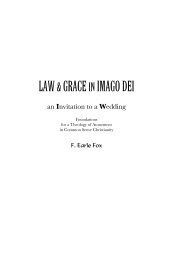Download entire 232-page book HERE (PDF ... - MassResistance
Download entire 232-page book HERE (PDF ... - MassResistance
Download entire 232-page book HERE (PDF ... - MassResistance
Create successful ePaper yourself
Turn your PDF publications into a flip-book with our unique Google optimized e-Paper software.
enefited from a cultural backlash to this phenomenon by posing as a moralist strongly opposed to<br />
homosexuality. He did in fact opportunistically condemn “homosexuality,” a term which at that time<br />
was almost exclusively associated with the effeminate type of same-sex relationships. The masculine<br />
faction (to which Hitler and many of the Nazi leaders and foot soldiers belonged) referred to its form<br />
of same-sex relations as “the love of friends.” This is not to suggest that Hitler was ever open about<br />
his lifestyle; he took great pains to hide it from the people, including the elimination of nearly every<br />
living person who had knowledge of his proclivities, which he accomplished through the bloody<br />
purge known as The Night of the Long Knives in 1934.<br />
During the years in which the Nazi Party was rising to power, Germany’s largest “gay” rights<br />
organization was the Society for Human Rights, which boasted Nazi SA Chief (and Hitler’s close<br />
friend) Ernst Roehm as one of its most prominent members. Roehm was killed during the Night of<br />
the Long Knives, when Hitler pretended to eliminate all homosexuality from his party. The actual<br />
purpose of the purge was not to eliminate homosexuality but to eliminate evidence of its existence<br />
in the party and to appease a powerful anti-Roehm political faction; in reality, the purge was<br />
conducted largely by homosexuals. Nevertheless, this incident was a major setback for the public “gay<br />
rights” movement, which then went mostly, but not <strong>entire</strong>ly, underground in Germany until after<br />
the war.<br />
The American Branch<br />
The first openly homosexual organization in the United States was a chapter of the Society for<br />
Human Rights. It was launched in Chicago in 1924 by a German-American soldier named Henry<br />
Gerber who had served in Germany after World War I. The organization was disbanded after Gerber<br />
and two other leaders were arrested on charges of sexually molesting boys. Gerber escaped jail by<br />
bribing the judge, and went underground but remained active both as a pederast and a political<br />
activist. He passed his dream of an American homosexual movement to one of his young conquests,<br />
Champ Simmons, who in turn, as an adult homosexual, passed it on to one of his own sexual<br />
“partners,” a boy named Harry Hay.<br />
Hay is today known as the “father” of the American homosexual movement. On August 10,<br />
1948, at the tail end of an eighteen-year stint as a Communist Party leader, Hay began to organize a<br />
group that would be called the Mattachine Society (ibid:132). Not until the spring of 1951 did it<br />
receive its name, but from the beginning it was seen as a vehicle to destroy social restraints against<br />
homosexuality in American culture (J. Katz:412f). The name Mattachine was taken from “medieval<br />
Renaissance French...secret fraternities of unmarried townsmen” (ibid. 4120). The organization’s<br />
stated agenda was to preserve the “right to privacy.” Like most of the early leaders of the American<br />
“gay” movement, Hay was an advocate of homosexual pedophilia and pederasty (adult/teen sex).<br />
It is likely that Hay secretly collaborated with Alfred Kinsey, but we have no proof of this<br />
connection. However, the advisory board of Hay’s Mattachine Society at one time included<br />
influential Kinsey co-worker, Wardell Pomeroy (infamous for his <strong>book</strong> Boys and Sex, which in part<br />
legitimizes sex with animals, and which I myself unfortunately read at the age of 12).<br />
Harry Hay and the Mattachine Society spawned large-scale political and social activism among<br />
homosexuals. Highly motivated activists began to operate in groups patterned after communist cells,<br />
each a “secret fraternity” whose members were bound by their common vice. As Hay stated in a later<br />
Redeeming the Rainbow 59






